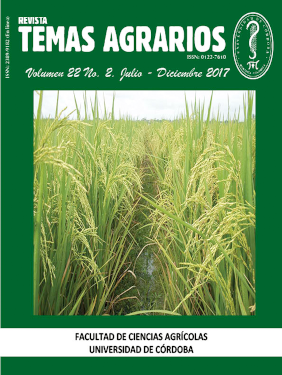Effect to early pruning of lateral shoots at the beginning of the papaya Tainung 1 flowering
Poda temprana de brotes laterales en el inicio de la floración de papaya Tainung 1

This work is licensed under a Creative Commons Attribution-NonCommercial 4.0 International License.
Show authors biography
The cultivation of papaya is mainly managed based on the traditional knowledge of the farmers, because the research in physiological aspects is scarce and there is no scientific information about the effect of the early pruning in the flowering. Pruning of lateral shoots usually takes place between 55 and 70 days after transplantation, when the first floral bud emerges, losing photoasimilates in the shoots in the first few days after the transplant. The aim of the study was to evaluate the effect of early pruning at the beginning of flowering of the Tainung 1 papaya. The study was carried out in the municipality of Caicedonia (Valle del Cauca). Planting distances were 2.5 m between furrows and 2 m between plants, treatments were with and without stripping. The experimental design was completely randomized. The experimental unit consisted of 20 plants, with four replicates. The variables evaluated were the height of the first floral bud, stem diameter, plant height, number of leaves and time of appearance of the
first floral bud. The variables height of the appearance of the first floral bud, the time elapsed for the appearance of the first bud and height of the plant presented highly significant differences (p<0.05) when the pruning was performed early. Obtaining a better behavior of the papaya with pruning, with reduction of the variables in the time of appearance of the flower buds (precocity), and height of the plant, which favors the process of production of the crop.
Article visits 1759 | PDF visits
Downloads
- Alonso, E., Ramos, R. y Torne, Q. 2008. Caracterización y evaluación de los recursos genéticos de papaya (Carica papaya Linn). CitriFrut, 23: 21-25.
- Alves, F. 2003. A cultura do mamão Carica papaya L., no mundo, no Brasil e no Estado do Espírito Santo. In: Martins, D.S. y Costa, A.F.S. A cultura do mamoeiro: tecnologias de produção. Vitória: Incaper, Cap. 1, p. 29.
- Arango, L., Roman, C., Salamanca, C., Almansa, E., Bernal, J., Leon, G., Rey, V., Ariza, M. y Gomez, P. 2002. El cultivo en los llanos orientales de Colombia. Manual de asistencia técnica, nº4. Ed. COPRPOICA, 99p.
- Arrieta, R. y Carrillo, A. 2002. Response of the papaya tree variety maradol at three subsurface drainage spacing distances. Terra, Chapingo, 20(4): 435-447.
- Costa, A. y Pacova, B. 2003. Caracterização de cultivares, estratégias e perspectivas do melhoramento genético do mamoeiro. In: Martins, D.S. y Costa, A.F. S. A cultura do mamoeiro: tecnologias de produção. Vitória: Incaper, Cap. 3, p. 59-102.
- Dantas, L., Dantas, A. y Lima, J. 2002. Mamoeiro. In: Bruckner, C.H (Eds). Melhoramento de fruteiras tropicais, Viçosa: UFV, p. 309-349.
- FAO. Faostat. 2016. Disponível em: <http://faostat.fao.org/site/339/default.aspx>. Acesso em: 26 ago. 2016.
- Ferreira, J., Schmidt, E., Schmidt, O.,
- Cattaneo, L., Sobreira, A. y Cruz, C. 2016. Comparison of methods for classification of the coefficient of variation in papaya. Revista Ceres, 63(2): 138-144.
- Landgren, C. y Ness, B. 2017. Plant Growth. Salem Press Encyclopedia Of Science [serial on the Internet]. [23 Abril 2017].
- Lopes, J., Coelho, R., Bregonci, I.,
- Macedo, C. y Maia, L. 2008. Brotação de mamoeiro tainung 1 submetido a diferentes alturas de corte do caule. Ciência e Agrotecnologia, 32: 360-365.
- Mahouachi, J., Pio, A., Socorro, R., Regalado, C. y Rodríguez, P. 2005. Respuestas de la papaya (Carica papaya L.) frente al estrés hídrico: crecimiento vegetativo y contenido de elementos minerales. Actas Portuguesas de Horticultura, 6: 193-199.
- Marin, S., Pereira, M., Amaral, J., Martelleto, L. y Ide, C. 2006. Heterosis in papaya hybrids from partial diallel of ¨Solo¨ and ¨Formosa¨ parents. Crop Breeding and Applied Biotechnology, 6: 24-29.
- Mendonça, V. y Mendeiros, L. 2011. Importância da fruticultura, poda das árvores frutíferas, propagação das plantas frutíferas. Boletim I. Mossoró, R
- Pereira, G., Marin, L., Martelleto, P., Ide, D., Martins, P. y Pereira, S. 2002. Melhoramento genético do mamoeiro (Carica papaya L.): comportamento de híbridos no norte do Estado do Rio de Janeiro. In: XVIII Congresso Brasileiro de Fruticultura: tecnologia, competitividade, sustentabilidade, Santa Catarina, Brasil.
- Pérez, R., Hernández, I., Cosio, E. y Sanchez, D. 2015. Nuevo activador fisiológico potencializador de la fructificación en papaya (Carica papaya L.). Revista Brasileira de Fruticultura, 37(4): 1065-1073
- Ramos, R. y Farrés, E. 2002. Nutrición en Papaya. In:Curso internacional de papaya, Guatemala. p.39-42.]
- Reyes, P., Murillo, A., Nieto, G., Troyo, D., Reynaldo, E., Rueda, P. y Guridi, I. 2014. Humates of vermicompost as mitigator of salinity in brasil (Ocimum basilicum L.). Revista da Facultad Ciencias Agrária, 46(2): 149-162.
- Rodríguez, C., Díaz, H., Pérez, G., Cruz, Z. y Rodríguez, H. 2014. Evaluation of quality and yield in papaya wild (Carica papaya L.) from Cuba. Cultivos Tropicales, San Jose´ de las Lajas, 35(3): 36-44.
- Storey, B. 1969. Papaya. In: Ferwerda, F.D. y Wit, F. eds., Outlines of perennial crop breeding in the tropics. Misc. Papers 4, Landbouwhogeschool, Wageningen, The Netherlands, p. 389-407




















